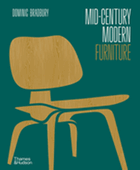
Mid-Century Modern Furniture is a coffee-table book that would look great on Vladimir Kagan's Tri-Symmetric Coffee Table (circa 1955), to name just one of several hundred mid-century marvels depicted in Dominic Bradbury's stately compendium. Bradbury (The Iconic Interior) bundles photographs of the featured pieces into eight themed chapters--"Chairs," "Chaises Longues," "Stools," "Sofas," "Tables," "Consoles & Credenzas," "Desks & Storage" and "Beds & Bedside"--and honors each subject with a biographical paragraph that puts the design in context. In his chapter introductions, Bradbury explains how pop art and technological innovations informed these pieces, as did designers' postwar drive to move beyond typical concerns (aesthetics, ergonomics) and toward a consideration of portability, adaptability and--so that enjoying good design wasn't restricted to the wealthy--affordability.
Mid-Century Modern Furniture is furniture porn for devotees of modern design, but it would also be a dandy introduction for casual admirers of the style. After appreciating the requisite Eames chair, readers can acquaint themselves with pieces that, as Bradbury writes of one designer's work, "inhabited the borderland between furniture and sculpture." Among these dazzlers are Eero Aarnio's Ball Chair (1966) and Pastilli Chair (1967), the latter resembling a giant squashed pea. Collectively, the images have a trippy, retro-futuristic look recalling A Clockwork Orange, but if readers find themselves thinking of James Bond movies instead, there's a good reason: two pieces--Bodil Kjaer's Office Suite (1959) and Olivier Mourgue's Whist Chaise Longue (1964)--had cameos in You Only Live Twice. --Nell Beram, author and freelance writer

